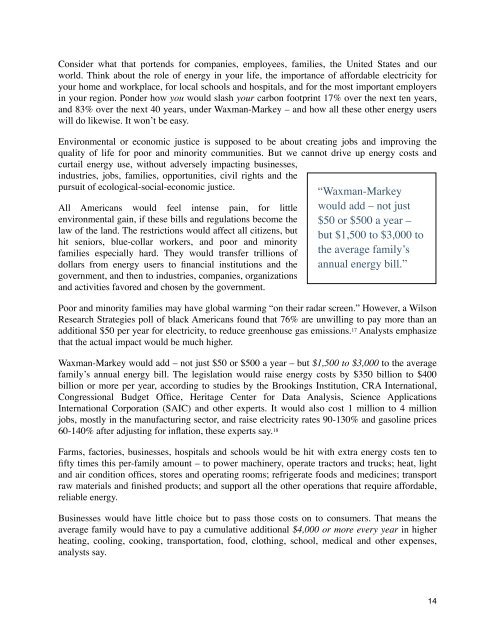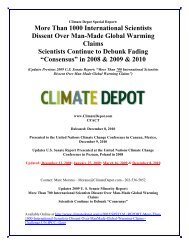to download the full report in PDF format - cfact
to download the full report in PDF format - cfact
to download the full report in PDF format - cfact
- No tags were found...
Create successful ePaper yourself
Turn your PDF publications into a flip-book with our unique Google optimized e-Paper software.
Committee For A Constructive Tomorrow • 1875 Eye Street NW • 5th Floor • Wash<strong>in</strong>g<strong>to</strong>n, DC 20006Consider what that portends for companies, employees, families, <strong>the</strong> United States and ourworld. Th<strong>in</strong>k about <strong>the</strong> role of energy <strong>in</strong> your life, <strong>the</strong> importance of affordable electricity foryour home and workplace, for local schools and hospitals, and for <strong>the</strong> most important employers<strong>in</strong> your region. Ponder how you would slash your carbon footpr<strong>in</strong>t 17% over <strong>the</strong> next ten years,and 83% over <strong>the</strong> next 40 years, under Waxman-Markey – and how all <strong>the</strong>se o<strong>the</strong>r energy userswill do likewise. It won’t be easy.Environmental or economic justice is supposed <strong>to</strong> be about creat<strong>in</strong>g jobs and improv<strong>in</strong>g <strong>the</strong>quality of life for poor and m<strong>in</strong>ority communities. But we cannot drive up energy costs andcurtail energy use, without adversely impact<strong>in</strong>g bus<strong>in</strong>esses,<strong>in</strong>dustries, jobs, families, opportunities, civil rights and <strong>the</strong>pursuit of ecological-social-economic justice.All Americans would feel <strong>in</strong>tense pa<strong>in</strong>, for littleenvironmental ga<strong>in</strong>, if <strong>the</strong>se bills and regulations become <strong>the</strong>law of <strong>the</strong> land. The restrictions would affect all citizens, buthit seniors, blue-collar workers, and poor and m<strong>in</strong>orityfamilies especially hard. They would transfer trillions ofdollars from energy users <strong>to</strong> f<strong>in</strong>ancial <strong>in</strong>stitutions and <strong>the</strong>government, and <strong>the</strong>n <strong>to</strong> <strong>in</strong>dustries, companies, organizationsand activities favored and chosen by <strong>the</strong> government.“Waxman-Markeywould add – not just$50 or $500 a year –but $1,500 <strong>to</strong> $3,000 <strong>to</strong><strong>the</strong> average family’sannual energy bill.”Poor and m<strong>in</strong>ority families may have global warm<strong>in</strong>g “on <strong>the</strong>ir radar screen.” However, a WilsonResearch Strategies poll of black Americans found that 76% are unwill<strong>in</strong>g <strong>to</strong> pay more than anadditional $50 per year for electricity, <strong>to</strong> reduce greenhouse gas emissions. 17 Analysts emphasizethat <strong>the</strong> actual impact would be much higher.Waxman-Markey would add – not just $50 or $500 a year – but $1,500 <strong>to</strong> $3,000 <strong>to</strong> <strong>the</strong> averagefamily’s annual energy bill. The legislation would raise energy costs by $350 billion <strong>to</strong> $400billion or more per year, accord<strong>in</strong>g <strong>to</strong> studies by <strong>the</strong> Brook<strong>in</strong>gs Institution, CRA International,Congressional Budget Office, Heritage Center for Data Analysis, Science ApplicationsInternational Corporation (SAIC) and o<strong>the</strong>r experts. It would also cost 1 million <strong>to</strong> 4 millionjobs, mostly <strong>in</strong> <strong>the</strong> manufactur<strong>in</strong>g sec<strong>to</strong>r, and raise electricity rates 90-130% and gasol<strong>in</strong>e prices60-140% after adjust<strong>in</strong>g for <strong>in</strong>flation, <strong>the</strong>se experts say. 18Farms, fac<strong>to</strong>ries, bus<strong>in</strong>esses, hospitals and schools would be hit with extra energy costs ten <strong>to</strong>fifty times this per-family amount – <strong>to</strong> power mach<strong>in</strong>ery, operate trac<strong>to</strong>rs and trucks; heat, lightand air condition offices, s<strong>to</strong>res and operat<strong>in</strong>g rooms; refrigerate foods and medic<strong>in</strong>es; transportraw materials and f<strong>in</strong>ished products; and support all <strong>the</strong> o<strong>the</strong>r operations that require affordable,reliable energy.Bus<strong>in</strong>esses would have little choice but <strong>to</strong> pass those costs on <strong>to</strong> consumers. That means <strong>the</strong>average family would have <strong>to</strong> pay a cumulative additional $4,000 or more every year <strong>in</strong> higherheat<strong>in</strong>g, cool<strong>in</strong>g, cook<strong>in</strong>g, transportation, food, cloth<strong>in</strong>g, school, medical and o<strong>the</strong>r expenses,analysts say.14



